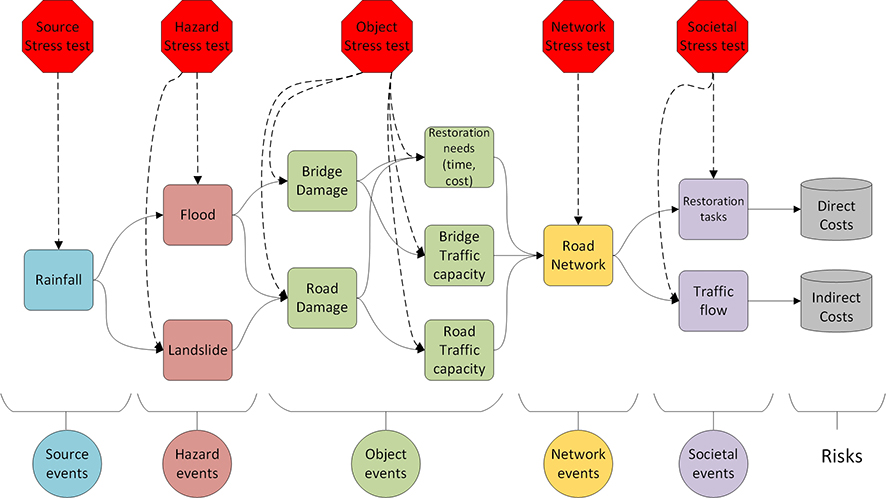
Transportation systems are vital for economic and social development, yet are susceptible to disruptions caused by natural hazards, especially considering the adverse impacts of climate change on increasing the intensity of frequency of climatic hazards. To manage these risks effectively, stress testing, as a diagnostic tool, has shown promise.
Industries such as banking have made significant efforts to adopt and even regulate stress testing as a complementary approach to traditional risk assessment, recognizing its ability to uncover hidden vulnerabilities and weaknesses that may not be apparent under typical risk assessments. Despite its success in these sectors, adoption of stress testing in transportation systems is lagging behind, highlighting the need for a standardized framework.
Extreme Scenarios
The «stress test framework» developed by the authors and the group of experts at the United Nations Economic Commission Europe (UNECE) defines a transportation system stress test as «a set of one or more hypothetical scenarios designed to help determine if a transport system can continue to provide an acceptable level of service when subjected to one or more potentially disruptive events.» Stress tests for transportation systems involve subjecting the network to extreme scenarios beyond what is typically considered in traditional risk assessments. These scenarios represent situations where part(s) of the system are significantly worse than expected or planned, e.g., extreme rainfall events happening more frequently than historically expected due to climate change, or assets having less resistance due to faster-than-expected deterioration.
Tailor-Made Stress Test
Defining stress tests involves identifying critical scenarios and variables that can significantly impact the transportation system’s performance. This process requires a thorough understanding of the system, including its components and their vulnerabilities, the environment that the system is embedded in, and the organization responsible for running the infrastructure. Stress tests should encompass a wide range of extreme conditions, such as natural hazards, performance of assets, increased demand on service provided by the system, or resource limitations to maintain or restore the level of service, in order to ensure comprehensive risk assessment. Moreover, stress tests should be tailored to specific objectives, considering the system’s unique characteristics and the stakeholders’ priorities. By defining stress tests thoughtfully, transportation planners and policymakers can uncover hidden vulnerabilities and develop effective risk management strategies to enhance system resilience.
To find out more, please refer to the UNECE stress test framework for transport systems and its implementation in a Swiss case study, featuring a transport system of roads and bridges subject to extreme scenarios of rainfall leading to flooding and landslide.
 Hossein Nasrazadani is a doctoral candidate at the Chair of Infrastructure Management at the D-BAUG, ETH Zurich. His scientific work is on modeling, assessment, and improvement of the risks and resilience of transport system against climate change hazards, including extreme scenarios of rainfall, flooding, and landslides. LinkedIn profile
Hossein Nasrazadani is a doctoral candidate at the Chair of Infrastructure Management at the D-BAUG, ETH Zurich. His scientific work is on modeling, assessment, and improvement of the risks and resilience of transport system against climate change hazards, including extreme scenarios of rainfall, flooding, and landslides. LinkedIn profile
Prof. Dr. Bryan T. Adey is the head of the Infrastructure Management Group in the Institute of Construction and Infrastructure Management at the D-BAUG, Swiss Federal Institute of Technology in Zürich (ETH Zürich). His research is focused on improving the effectiveness and efficiency of infrastructure management. This includes the definition and standardization of the infrastructure management process, from setting goals to determining optimal monitoring and intervention programmes, and evaluating the performance of infrastructure management organisations. It also includes the automation of parts of the infrastructure management process, e.g. the determination of optimal intervention strategies for single infrastructure objects and the development of algorithms to generate network intervention plans that maximise net benefit. Other themes of his research are estimating the risk related to infrastructure, including estimating infrastructure behaviour when subject to extreme events, estimating the resilience of the infrastructure and the system in which it is embedded, and estimating the optimal ways to restore infrastructure following extreme events. Prof. Adey works on infrastructure management issues related to many types of infrastructure, including road networks, rail networks, water distribution networks, sewer networks and building portfolios.


